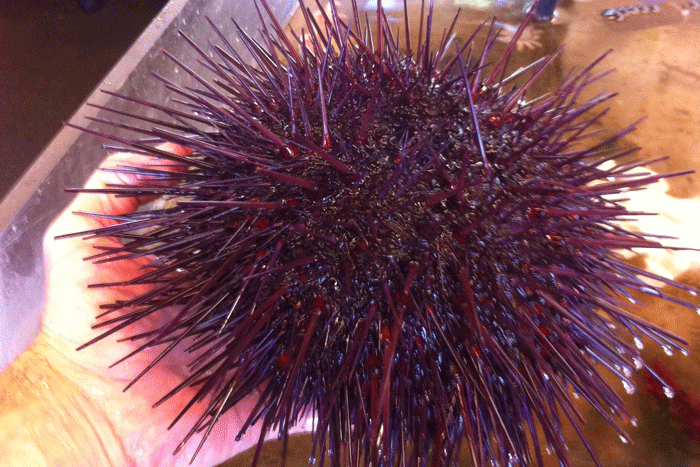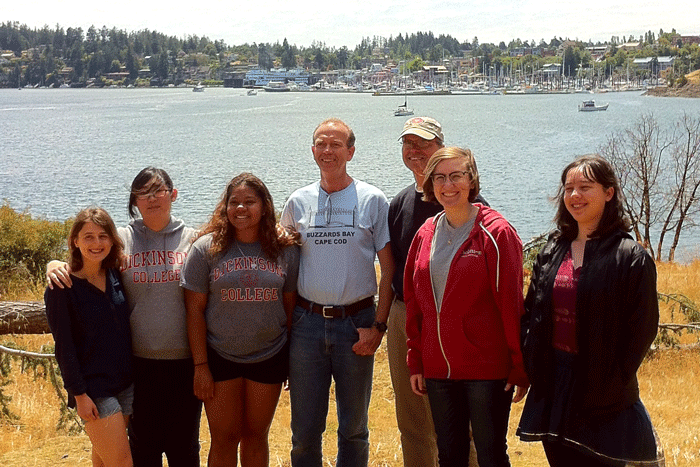North by Northwest

The Dickinson team discovered this huge sea urchin (scientific name Strongylocentrotus franciscanis), which is in the same genus as the sea urchins at the heart of Professor of Biology John Henson's students' research. Recent research suggests that animals this size are probably over 100 years old. Photo courtesy of John Henson.
Ocean research takes students to Washington state’s San Juan Islands
by Tony Moore
When you’ve run out of real estate trekking northwest across the continental U.S., between Seattle and Vancouver, British Columbia, you’ll find the San Juan Islands. The group of nearly 200 islands and reefs is a mecca for whale-watchers, kayakers and hikers, and its official tagline is “inspiration for the senses.”
But those whales and kayaks and hiking boots aside, the San Juan Islands also provide plenty of inspiration for biologists and environmental scientists. And a group of Dickinson students experienced it firsthand last summer, via a research trip to the University of Washington’s Friday Harbor Laboratories.
Living in the lab
“I worked in the Ocean Acidification Environmental Lab, studying the effects of acidic environments on the mollusk larvae Crepidula fornicata,” says Ali Resnikoff ’18 (neuroscience, biochemistry & molecular biology), who spent eight weeks of her summer at Friday Harbor. “Working out in Washington on an island was amazing, and living in a marine biology lab had its perks: We were able to see whales and seals along with a lot of other cool marine organisms, and whenever we needed a break from the microscope we could just walk right outside the lab and see the ocean.”
(And speaking of cool marine organisms, check out the below video, in which giant marine worms spawn, attracted by students "nightlighting" the water. Their normal spawning cue is a full moon.)
With Professor of Biology Tony Pires, Resnikoff and two other students studied the impact of ocean acidification on the larvae of the marine snail—acidification that is a result of the ocean absorbing rising levels of CO2 in the atmosphere. Another group studied the mechanism of cell division in sea urchin embryos with John Henson, Charles A. Dana Professor of Biology and senior associate provost for academic affairs. Both studies were supported by National Science Foundation grants.
“The great thing about these summer research institutes is that they concentrate students and faculty from all over the world, so they have an exciting atmosphere that transcends all kinds of institutions,” says Henson. “They’ve got folks from all walks of life in terms of science, in intimate, collaborative places. It’s a rich, vibrant atmosphere to expose undergraduates to, particularly.”
Beyond undergraduates such as those from Dickinson, that atmosphere contains graduate and postdoctoral students from major research universities and small colleges alike—all working toward varying goals in interconnected spheres.
“Getting a chance to live the culture of a research organization where everyone is totally invested in doing science is a transformational experience for students,” says Pires. “And it provides practical credentials for professional advancement after graduation.”
“The trip exposed me to a lot of fields of study in biology—marine, invertebrate, etc.—that I hadn’t seen much of before and made me think about branching out from molecular biology after college,” says Zoe Irons '18 (biochemistry & molecular biology), whose three-week research stint included fertilizing sea urchin eggs. “And it was an absolutely beautiful place to live and do research.”

From left: Ali Resnikoff '18, Christine Choi '16, Rulaiha Taylor '18, Tony Pires, John Henson, Courtney Gamache '18 and Zoe Irons '18.
Continuing research, continued
The trip marked Henson’s second trip to Friday Harbor, while Pires has spent many summers there doing research with Dickinson students.
“There are significant logistical challenges to doing experiments on the biological effects of ocean acidification,” Pires says. “So it’s a tremendous advantage to work in Friday Harbor’s Ocean Acidification Environmental Lab, which is specifically set up for that purpose.”
Henson, whose group was tackling anew the longstanding question of exactly how cells divide, also finds distinct advantages to conducting research at the site.
“Our subjects are sea urchins, and it turns out the particular specimens we can find off the coast of Washington are especially helpful for our research,” he says. “The health of those organisms is better for us at Friday Harbor, given that they don't do as well in closed aquarium systems, and we can also get embryos from them in a non-destructive manner.”
Henson and his students will be presenting their research at a meeting on Cape Cod in April. So while the experience will continue long after students have gone back to their campus routines, it also left other lasting marks.
“I am definitely more interested in research as a whole now, and I’m planning to continue this research in the spring,” says Resnikoff. “I loved my Dickinson team and cannot wait to keep doing research with them.”
Learn more
- Department of Biology
- Department of Biochemistry & Molecular Biology
- Students as Scholars
- Research at Dickinson
- Latest News
Published January 12, 2017